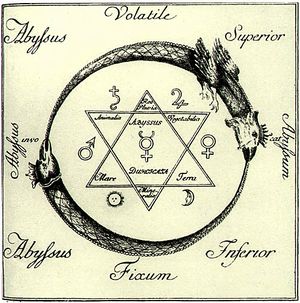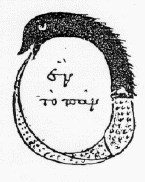Dobbs 1975 Cambridge Univ Press: Difference between revisions
From Bioblast
No edit summary |
No edit summary |
||
| Line 1: | Line 1: | ||
{{Publication | {{Publication | ||
|title=Dobbs BJT (1975) The foundations of Newton's alchemy or "The hunting of the Greene Lyon". Cambridge Univ Press Cambridge:300 pp. | |title=Dobbs BJT (1975) The foundations of Newton's alchemy or "The hunting of the Greene Lyon". Reissued as a paperback 1983. Cambridge Univ Press Cambridge:300 pp. | ||
|authors=Dobbs BJT | |authors=Dobbs BJT | ||
|year=1975 | |year=1975 | ||
| Line 6: | Line 6: | ||
|editor=[[Gnaiger E]], | |editor=[[Gnaiger E]], | ||
}} | }} | ||
== Some citations == | |||
[[File:Volatile 1.jpg|right|300px]] | |||
::::* But in fact his effort to integrate alchemy and mechanism seem to have produced one of his best virtuoso performances: the creation of a new concept of force. - (p xii) | |||
::::* Here Jung has done some of his most important work: in identifying the great mysterious symbols of alchemy as psychic images. These all-pervasive symbols occur throughoutthe literature of alchemy: Flamel's dragons - one winged and one wingless. - (p 32) | |||
:::::: <small>''Tractatus brevis, sive sumarivm philosophicum, Nocolai Flamelli'' in ''MHRA'' (''Musaeum hermeticum reformatum et amplificatum'', indrod. by Karl R.H. Frick, introduction translated by C.A. Burland, Graz: Akademische Druck-u. Verlagsanstalt, 1970), pp. 172-73 (2, n. 13): "Dicta ista duo spermata veteres sapientes duos Dracones vel serpentes praefigurarunt, quorum unus alas, alter autem nullas habuit. Draco sine alis suphur est, numquam ab igne avolans. Alatus serpenmt argentum vivum est, quod à vento transportatur...."</small> | |||
[[File:SassAdam3.jpg|right|300px]] | |||
<br /> | |||
::::* If and when the psyche found itself able to fuse these archetypal opposites into its new "self," symbols of wholeness and unity appeared, such as the [[Oroboros symbol |ourobouros]], .. - (p 33-34) | |||
:::::: <small>Lambsprinck's Sixth Figure, ''MHRA'' p. 353 (2, n. 13), shows the dragon biting its own tail with the accompanying text: "Hoc verè est magnum miraculum & cita fraus / In venenoso Dracone summem medicinam inesse." The ourobouros is one of the oldest of alchemical symbols. One from ancient Greece, bearing the text, "One is all, and by it all, and to it all, and if one does not contain all, all is nought," has been reproduced in John Read, ''Through Alchemy to Chemistry. A procession of Ideas & Personalities'' (Harper Torchbooks; New Aork and Evanston: Harper & Row, 1963, p. 25.</small> | |||
<br /> | |||
::::* Newton looked for no less than the structure of the world in alchemy - a sstem of the small world to match with his system of the greater. Having found out the [[force]] which held the planets in their orbits, he remained unsatisfied. "I wish," he said in the preface to the first edition of the ''Principia'', "that we could derive the rest of the phenomena of Nature by the same kind of reasoning from mechanical principles...." - (p 88) | |||
<br /> | |||
Revision as of 20:45, 26 December 2018
| Dobbs BJT (1975) The foundations of Newton's alchemy or "The hunting of the Greene Lyon". Reissued as a paperback 1983. Cambridge Univ Press Cambridge:300 pp. |
Dobbs BJT (1975) Cambridge Univ Press
Abstract:
• Bioblast editor: Gnaiger E
Some citations
- But in fact his effort to integrate alchemy and mechanism seem to have produced one of his best virtuoso performances: the creation of a new concept of force. - (p xii)
- Here Jung has done some of his most important work: in identifying the great mysterious symbols of alchemy as psychic images. These all-pervasive symbols occur throughoutthe literature of alchemy: Flamel's dragons - one winged and one wingless. - (p 32)
- Tractatus brevis, sive sumarivm philosophicum, Nocolai Flamelli in MHRA (Musaeum hermeticum reformatum et amplificatum, indrod. by Karl R.H. Frick, introduction translated by C.A. Burland, Graz: Akademische Druck-u. Verlagsanstalt, 1970), pp. 172-73 (2, n. 13): "Dicta ista duo spermata veteres sapientes duos Dracones vel serpentes praefigurarunt, quorum unus alas, alter autem nullas habuit. Draco sine alis suphur est, numquam ab igne avolans. Alatus serpenmt argentum vivum est, quod à vento transportatur...."
- If and when the psyche found itself able to fuse these archetypal opposites into its new "self," symbols of wholeness and unity appeared, such as the ourobouros, .. - (p 33-34)
- Lambsprinck's Sixth Figure, MHRA p. 353 (2, n. 13), shows the dragon biting its own tail with the accompanying text: "Hoc verè est magnum miraculum & cita fraus / In venenoso Dracone summem medicinam inesse." The ourobouros is one of the oldest of alchemical symbols. One from ancient Greece, bearing the text, "One is all, and by it all, and to it all, and if one does not contain all, all is nought," has been reproduced in John Read, Through Alchemy to Chemistry. A procession of Ideas & Personalities (Harper Torchbooks; New Aork and Evanston: Harper & Row, 1963, p. 25.
- Newton looked for no less than the structure of the world in alchemy - a sstem of the small world to match with his system of the greater. Having found out the force which held the planets in their orbits, he remained unsatisfied. "I wish," he said in the preface to the first edition of the Principia, "that we could derive the rest of the phenomena of Nature by the same kind of reasoning from mechanical principles...." - (p 88)


